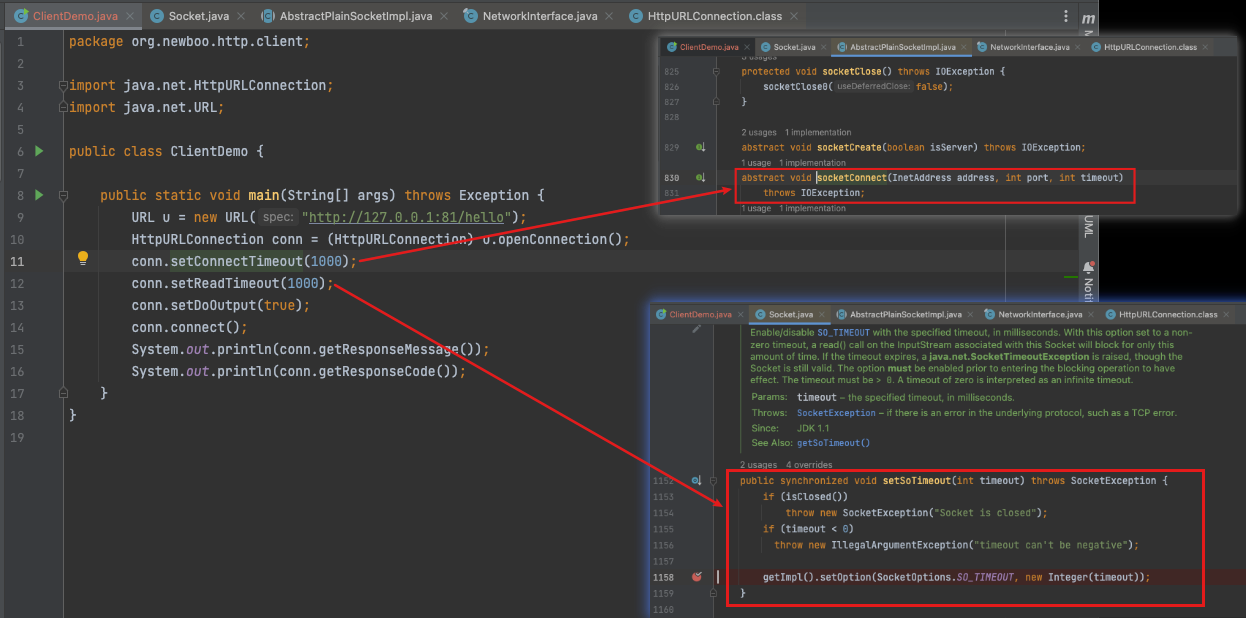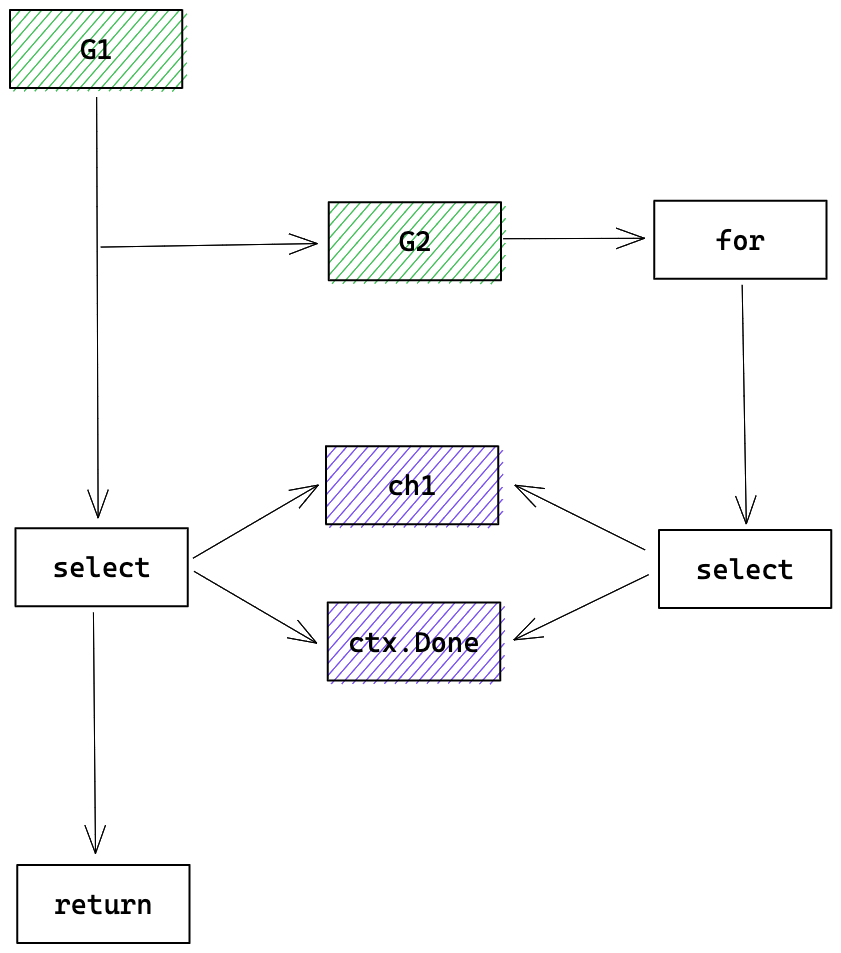

有趣的 Go HttpClient 超时机制 - 捉虫大师
source link: https://www.cnblogs.com/zhuochongdashi/p/16893627.html
Go to the source link to view the article. You can view the picture content, updated content and better typesetting reading experience. If the link is broken, please click the button below to view the snapshot at that time.

hello,大家好呀,我是既写 Java 又写 Go 的小楼,在写 Go 的过程中经常对比这两种语言的特性,踩了不少坑,也发现了不少有意思的地方,今天就来聊聊 Go 自带的 HttpClient 的超时机制。
Java HttpClient 超时底层原理
在介绍 Go 的 HttpClient 超时机制之前,我们先看看 Java 是如何实现超时的。
写一个 Java 原生的 HttpClient,设置连接超时、读取超时时间分别对应到底层的方法分别是:

再追溯到 JVM 源码,发现是对系统调用的封装,其实不光是 Java,大部分的编程语言都借助了操作系统提供的超时能力。
然而 Go 的 HttpClient 却提供了另一种超时机制,挺有意思,我们来盘一盘。但在开始之前,我们先了解一下 Go 的 Context。
Go Context 简介
Context 是什么?
根据 Go 源码的注释:
// A Context carries a deadline, a cancellation signal, and other values across
// API boundaries.
// Context's methods may be called by multiple goroutines simultaneously.
Context 简单来说是一个可以携带超时时间、取消信号和其他数据的接口,Context 的方法会被多个协程同时调用。
Context 有点类似 Java 的ThreadLocal,可以在线程中传递数据,但又不完全相同,它是显示传递,ThreadLocal 是隐式传递,除了传递数据之外,Context 还能携带超时时间、取消信号。
Context 只是定义了接口,具体的实现在 Go 中提供了几个:
- Background :空的实现,啥也没做
- TODO:还不知道用什么 Context,先用 TODO 代替,也是啥也没做的空 Context
- cancelCtx:可以取消的 Context
- timerCtx:主动超时的 Context
针对 Context 的三个特性,可以通过 Go 提供的 Context 实现以及源码中的例子来进一步了解下。
Context 三个特性例子
这部分的例子来源于 Go 的源码,位于 src/context/example_test.go
使用 context.WithValue 来携带,使用 Value 来取值,源码中的例子如下:
// 来自 src/context/example_test.go
func ExampleWithValue() {
type favContextKey string
f := func(ctx context.Context, k favContextKey) {
if v := ctx.Value(k); v != nil {
fmt.Println("found value:", v)
return
}
fmt.Println("key not found:", k)
}
k := favContextKey("language")
ctx := context.WithValue(context.Background(), k, "Go")
f(ctx, k)
f(ctx, favContextKey("color"))
// Output:
// found value: Go
// key not found: color
}
先起一个协程执行一个死循环,不停地往 channel 中写数据,同时监听 ctx.Done() 的事件
// 来自 src/context/example_test.go
gen := func(ctx context.Context) <-chan int {
dst := make(chan int)
n := 1
go func() {
for {
select {
case <-ctx.Done():
return // returning not to leak the goroutine
case dst <- n:
n++
}
}
}()
return dst
}
然后通过 context.WithCancel 生成一个可取消的 Context,传入 gen 方法,直到 gen 返回 5 时,调用 cancel 取消 gen 方法的执行。
// 来自 src/context/example_test.go
ctx, cancel := context.WithCancel(context.Background())
defer cancel() // cancel when we are finished consuming integers
for n := range gen(ctx) {
fmt.Println(n)
if n == 5 {
break
}
}
// Output:
// 1
// 2
// 3
// 4
// 5
这么看起来,可以简单理解为在一个协程的循环中埋入结束标志,另一个协程去设置这个结束标志。
有了 cancel 的铺垫,超时就好理解了,cancel 是手动取消,超时是自动取消,只要起一个定时的协程,到时间后执行 cancel 即可。
设置超时时间有2种方式:context.WithTimeout 与 context.WithDeadline,WithTimeout 是设置一段时间后,WithDeadline 是设置一个截止时间点,WithTimeout 最终也会转换为 WithDeadline。
// 来自 src/context/example_test.go
func ExampleWithTimeout() {
// Pass a context with a timeout to tell a blocking function that it
// should abandon its work after the timeout elapses.
ctx, cancel := context.WithTimeout(context.Background(), shortDuration)
defer cancel()
select {
case <-time.After(1 * time.Second):
fmt.Println("overslept")
case <-ctx.Done():
fmt.Println(ctx.Err()) // prints "context deadline exceeded"
}
// Output:
// context deadline exceeded
}
Go HttpClient 的另一种超时机制
基于 Context 可以设置任意代码段执行的超时机制,就可以设计一种脱离操作系统能力的请求超时能力。
超时机制简介
看一下 Go 的 HttpClient 超时配置说明:
client := http.Client{
Timeout: 10 * time.Second,
}
// 来自 src/net/http/client.go
type Client struct {
// ... 省略其他字段
// Timeout specifies a time limit for requests made by this
// Client. The timeout includes connection time, any
// redirects, and reading the response body. The timer remains
// running after Get, Head, Post, or Do return and will
// interrupt reading of the Response.Body.
//
// A Timeout of zero means no timeout.
//
// The Client cancels requests to the underlying Transport
// as if the Request's Context ended.
//
// For compatibility, the Client will also use the deprecated
// CancelRequest method on Transport if found. New
// RoundTripper implementations should use the Request's Context
// for cancellation instead of implementing CancelRequest.
Timeout time.Duration
}
翻译一下注释:Timeout 包括了连接、redirect、读取数据的时间,定时器会在 Timeout 时间后打断数据的读取,设为0则没有超时限制。
也就是说这个超时是一个请求的总体超时时间,而不必再分别去设置连接超时、读取超时等等。
这对于使用者来说可能是一个更好的选择,大部分场景,使用者不必关心到底是哪部分导致的超时,而只是想这个 HTTP 请求整体什么时候能返回。
超时机制底层原理
以一个最简单的例子来阐述超时机制的底层原理。
这里我起了一个本地服务,用 Go HttpClient 去请求,超时时间设置为 10 分钟,建议使 Debug 时设置长一点,否则可能超时导致无法走完全流程。
client := http.Client{
Timeout: 10 * time.Minute,
}
resp, err := client.Get("http://127.0.0.1:81/hello")
1. 根据 timeout 计算出超时的时间点
// 来自 src/net/http/client.go
deadline = c.deadline()
2. 设置请求的 cancel
// 来自 src/net/http/client.go
stopTimer, didTimeout := setRequestCancel(req, rt, deadline)
这里返回的 stopTimer 就是可以手动 cancel 的方法,didTimeout 是判断是否超时的方法。这两个可以理解为回调方法,调用 stopTimer() 可以手动 cancel,调用 didTimeout() 可以返回是否超时。
设置的主要代码其实就是将请求的 Context 替换为 cancelCtx,后续所有的操作都将携带这个 cancelCtx:
// 来自 src/net/http/client.go
var cancelCtx func()
if oldCtx := req.Context(); timeBeforeContextDeadline(deadline, oldCtx) {
req.ctx, cancelCtx = context.WithDeadline(oldCtx, deadline)
}
同时,再起一个定时器,当超时时间到了之后,将 timedOut 设置为 true,再调用 doCancel(),doCancel() 是调用真正 RoundTripper (代表一个 HTTP 请求事务)的 CancelRequest,也就是取消请求,这个跟实现有关。
// 来自 src/net/http/client.go
timer := time.NewTimer(time.Until(deadline))
var timedOut atomicBool
go func() {
select {
case <-initialReqCancel:
doCancel()
timer.Stop()
case <-timer.C:
timedOut.setTrue()
doCancel()
case <-stopTimerCh:
timer.Stop()
}
}()
Go 默认 RoundTripper CancelRequest 实现是关闭这个连接
// 位于 src/net/http/transport.go
// CancelRequest cancels an in-flight request by closing its connection.
// CancelRequest should only be called after RoundTrip has returned.
func (t *Transport) CancelRequest(req *Request) {
t.cancelRequest(cancelKey{req}, errRequestCanceled)
}
3. 获取连接
// 位于 src/net/http/transport.go
for {
select {
case <-ctx.Done():
req.closeBody()
return nil, ctx.Err()
default:
}
// ...
pconn, err := t.getConn(treq, cm)
// ...
}
代码的开头监听 ctx.Done,如果超时则直接返回,使用 for 循环主要是为了请求的重试。
后续的 getConn 是阻塞的,代码比较长,挑重点说,先看看有没有空闲连接,如果有则直接返回
// 位于 src/net/http/transport.go
// Queue for idle connection.
if delivered := t.queueForIdleConn(w); delivered {
// ...
return pc, nil
}
如果没有空闲连接,起个协程去异步建立,建立成功再通知主协程
// 位于 src/net/http/transport.go
// Queue for permission to dial.
t.queueForDial(w)
再接着是一个 select 等待连接建立成功、超时或者主动取消,这就实现了在连接过程中的超时
// 位于 src/net/http/transport.go
// Wait for completion or cancellation.
select {
case <-w.ready:
// ...
return w.pc, w.err
case <-req.Cancel:
return nil, errRequestCanceledConn
case <-req.Context().Done():
return nil, req.Context().Err()
case err := <-cancelc:
if err == errRequestCanceled {
err = errRequestCanceledConn
}
return nil, err
}
4. 读写数据
在上一条连接建立的时候,每个链接还偷偷起了两个协程,一个负责往连接中写入数据,另一个负责读数据,他们都监听了相应的 channel。
// 位于 src/net/http/transport.go
go pconn.readLoop()
go pconn.writeLoop()
其中 wirteLoop 监听来自主协程的数据,并往连接中写入
// 位于 src/net/http/transport.go
func (pc *persistConn) writeLoop() {
defer close(pc.writeLoopDone)
for {
select {
case wr := <-pc.writech:
startBytesWritten := pc.nwrite
err := wr.req.Request.write(pc.bw, pc.isProxy, wr.req.extra, pc.waitForContinue(wr.continueCh))
// ...
if err != nil {
pc.close(err)
return
}
case <-pc.closech:
return
}
}
}
同理,readLoop 读取响应数据,并写回主协程。读与写的过程中如果超时了,连接将被关闭,报错退出。
超时机制小结
Go 的这种请求超时机制,可随时终止请求,可设置整个请求的超时时间。其实现主要依赖协程、channel、select 机制的配合。总结出套路是:
- 主协程生成 cancelCtx,传递给子协程,主协程与子协程之间用 channel 通信
- 主协程 select channel 和 cancelCtx.Done,子协程完成或取消则 return
- 循环任务:子协程起一个循环处理,每次循环开始都 select cancelCtx.Done,如果完成或取消则退出
- 阻塞任务:子协程 select 阻塞任务与 cancelCtx.Done,阻塞任务处理完或取消则退出
以循环任务为例

Java 能实现这种超时机制吗
直接说结论:暂时不行。
首先 Java 的线程太重,像 Go 这样一次请求开了这么多协程,换成线程性能会大打折扣。
其次 Go 的 channel 虽然和 Java 的阻塞队列类似,但 Go 的 select 是多路复用机制,Java 暂时无法实现,即无法监听多个队列是否有数据到达。所以综合来看 Java 暂时无法实现类似机制。
本文介绍了 Go 另类且有趣的 HTTP 超时机制,并且分析了底层实现原理,归纳出了这种机制的套路,如果我们写 Go 代码,也可以如此模仿,让代码更 Go。这期是我写的 Go 底层原理第一期,求个 赞、在看、分享,我们下期再见。
- 搜索关注微信公众号"捉虫大师",后端技术分享,架构设计、性能优化、源码阅读、问题排查、踩坑实践。
Recommend
About Joyk
Aggregate valuable and interesting links.
Joyk means Joy of geeK